Executive summary
- Pressure has continued in emergency departments across the country, with 2.1 million attendances and 535,000 emergency admissions in July. Ambulance services also faced their busiest month since May 2022, with 707,000 incidents in July, but performance was nonetheless significantly improved on last year.
- Continuing industrial action in the NHS has had a significant impact on patients, with around 778,000 appointments having to be rescheduled due to strike action in the last several months—and more not scheduled due to ongoing disruption.
- The most recent data shows NHS staff are continuing to make progress on reducing the longest waits for care. As of the end of June, the number of patients waiting more than 78 weeks for treatment is down more than 90% from a peak of 124,911 in September 2021.
- Occupancy in acute beds remains high with patient flow through hospitals a key challenge, with ongoing pressures in social and community care. We have published again this month additional information which explains the reasons why patients have experienced delays in leaving acute and community hospitals, as well as where they have been discharged to.
- The NHS continues to increase support to those outside of hospital. Urgent Community Response helps avoid hospital admissions by providing urgent care to people in their homes. ICBs now have full coverage and the latest data shows that nationally 84% of patients were seen within the 2-hour standard, with every region exceeding or meeting the 70% target in the Planning Guidance.
- In diagnostics, the NHS has increased community access and overall activity levels. A record number of tests and checks were carried out for the month of June (2.24 million), up 16% on the same month pre-pandemic (1.9 million). Over the past 12 months (July 2022 – June 2023) more than 25 million checks and scans have been carried out.
- The NHS continues to see high demand for cancer services. In June 2023, 261,000 people were referred for urgent cancer checks by their GP, which is 22% higher than we saw before the pandemic. Treatment is also at record levels and there has been a reduction in the 62-day cancer backlog as a result, while cancer deaths are around 10% lower in the UK compared to just 5 years ago.
- Good progress continues to be made in activity levels in general practice. In June 2023, 29.7 million GP appointments took place, of which 289,000 were COVID-19 vaccinations. 43.3% of appointments in June took place on the same day that they were booked, and 69.0% were carried out face to face.
Urgent and emergency care
Urgent and emergency care (UEC) services sustained progress against the ambitions set out in our UEC Recovery Plan [1] in July.
This is despite back-to-back industrial action, showing the preparation NHS teams are taking to help patients get the care they need more quickly.
Ambulance performance is significantly better compared to the same time last year [2]. In July, the average ambulance response time for a category 2 call was 31 minutes and 50 seconds. This is an improvement of almost 5 minutes when compared with June [3].
Average C2 response times, England
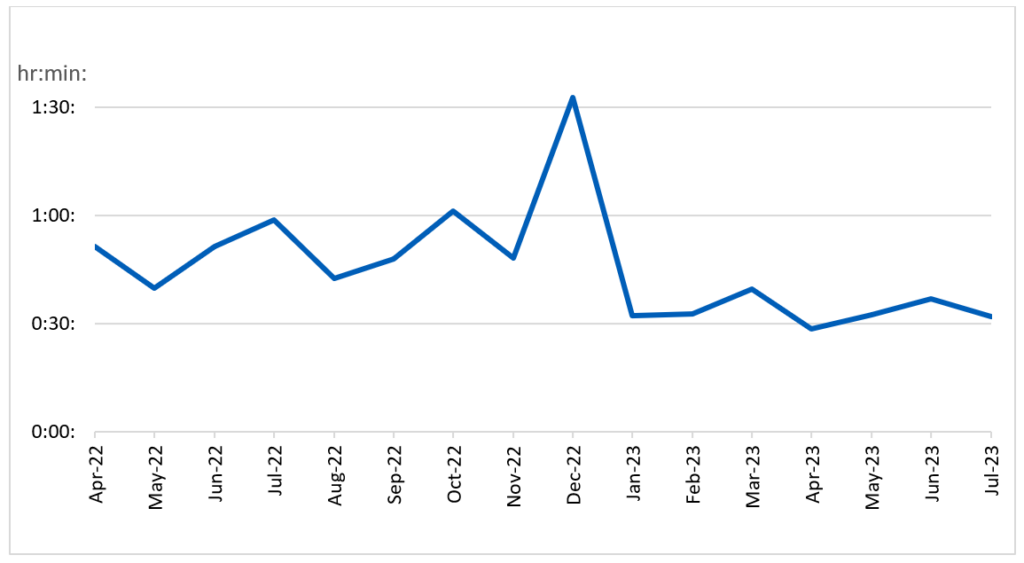
A&E performance has also improved. 74% of patients attending A&E were admitted, transferred or discharged within four hours. This compares with 73.3% last month and 71.1% in July 2022.
Fewer patients waited 12 hours or more in A&E. In July, 7.3% of patients spent 12 hours from arrival in A&E. This is down from 10.8% in March 2023.
Meeting the recovery plan ambitions will require a continuous focus on expanding health and care outside of hospital. By better supporting people at home, we can help improve patient experience, avoid unnecessary admissions and improve discharge.
One example of this is our aim to scale up capacity to more than 10,000 virtual ward beds by the end of September. This month, we have published data on virtual wards. July’s data shows 9,713 virtual ward beds are currently available.
Virtual wards build on clinical best practice and allow people to get hospital-level care at home safely and in familiar surroundings, helping speed up their recovery while freeing up hospital beds for patients that need them most.
Elective recovery and cancer
Despite a three-day junior doctor strike, during which 106,000 appointments were postponed, the NHS continued to reduce the longest waits for planned care in June.
As of the end of June, 7,177 patients were waiting more than 78 weeks for treatment. This is down from a peak of 124,911 in September 2021 and has reduced by more than a third since last month .
Referral to treatment 78 week waits
Including estimates for missing acute trusts.
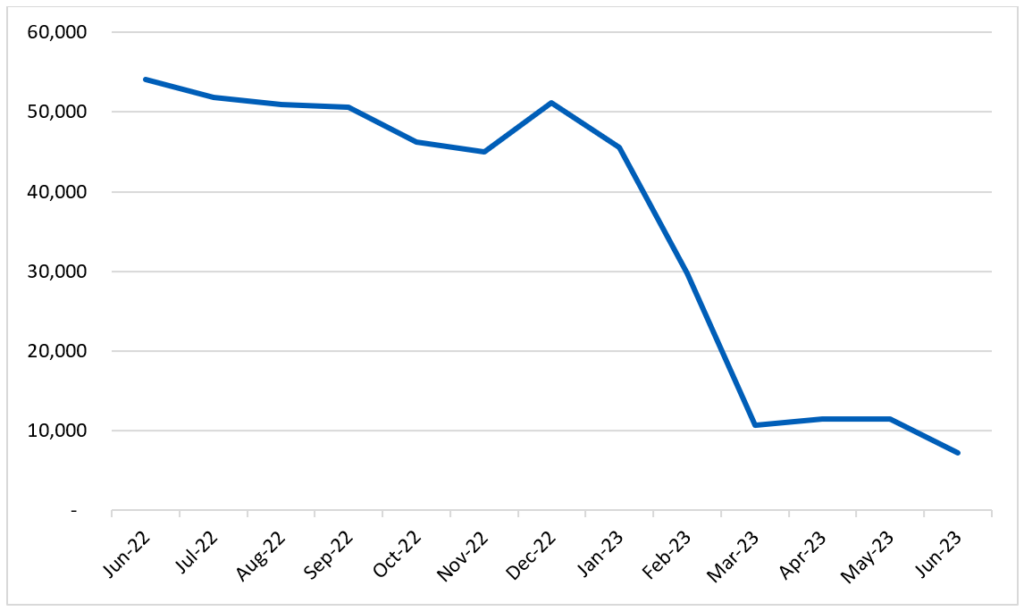
97,275 (1.3%) patients were waiting more than 65 weeks for treatment. This is down by almost a third since the start of the year [5] .
Approximately 80% of patients on the waiting list will not need admission to hospital for their treatment. Instead, they either require a diagnostic test or outpatient care. In June, 1,217,525 patients started this ‘non-admitted’ treatment, an increase from 1,168,335 in May.
Demand for cancer services continued at record levels in June, with the number of urgent suspected cancer referrals at 122% of pre-pandemic levels.
To meet high demand, treatment is also at record levels and there has been a reduction in the 62-day cancer backlog as a result.
Trend in patients waiting more than 62 days
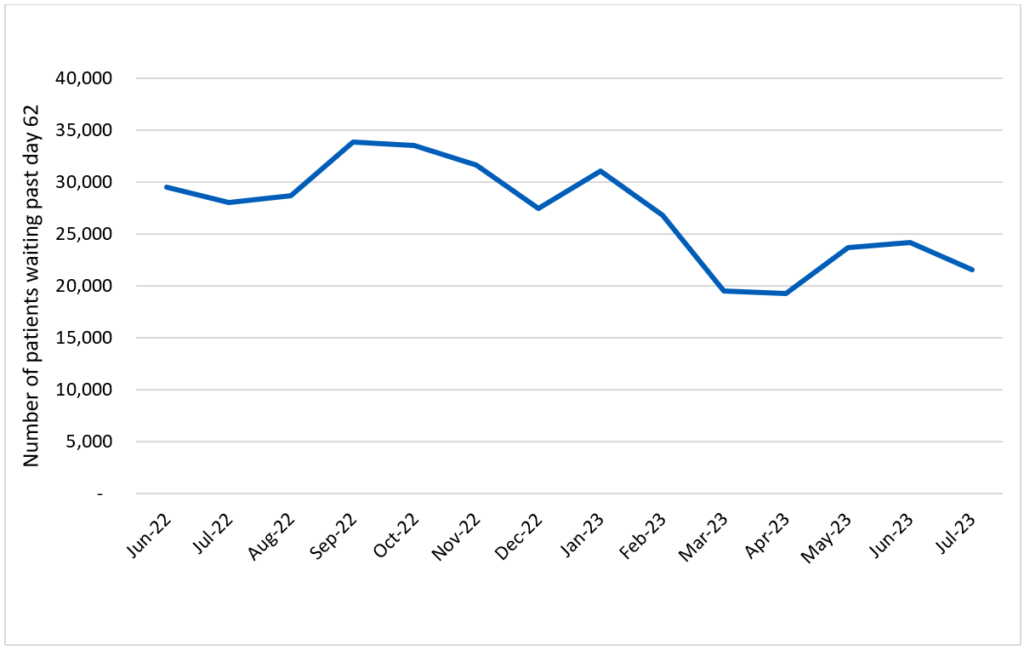
Over 335,000 people received treatment for cancer over the last year between July 2022 and June 2023 – the highest year on record, and up by more than 22,000 on the same period pre-pandemic.
GPs have been referring people for urgent cancer checks in record numbers since March 2021. Since then, NHS staff have seen over 930,000 more people than in the same period prior to the pandemic.
Urgent suspected cancer referrals first seen
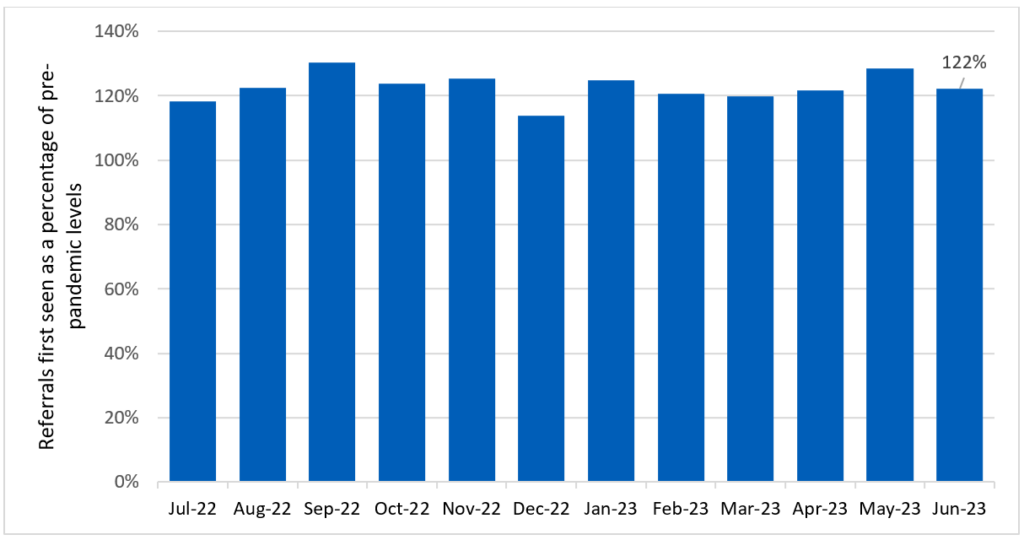
The increase in referrals has contributed to the NHS diagnosing more cancer at an early stage than ever before. We are diagnosing a higher proportion of cancers at an early stage now than ever before – about 2% higher than before the pandemic.
Survival is also at an all-time high. In 2023, the Annals of Oncology published findings showing that cancer deaths are around 10% lower in the UK compared to just 5 years ago.
Cancer early diagnosis rate across England
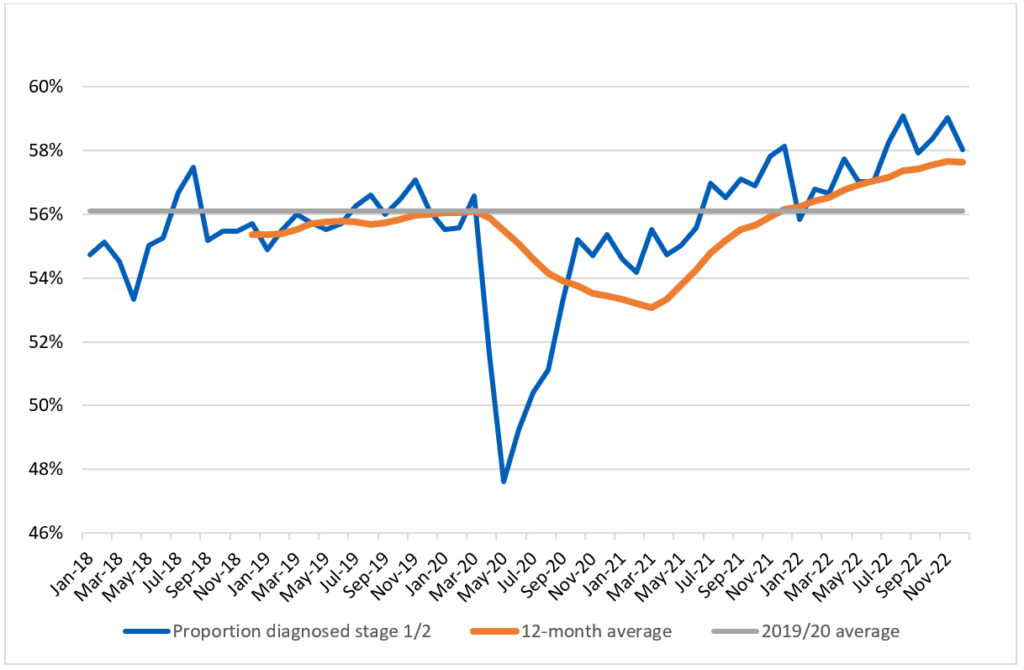
The NHS is working hard to keep up with this increase in demand. It has been accelerating the installation of new diagnostic capacity, much of it in Community Diagnostic Centres.
The backlog has already reduced by 14,000 people since its peak last summer, and despite the recent seasonal increase, NHS staff remain focused on ensuring that people who have been waiting longest or who need care most urgently are seen first.
Mental health
More people than ever before now receive NHS support for their mental health, with five million patients accessing care in 2021/22, an increase of more than one million in five years.
Services across the country have made great efforts to improve access and reduce waiting times, against a backdrop of increased needs and complex conditions. This is particularly the case for children and young people, with one in six now experiencing a mental condition, an increase from one in nine in 2017.
The pandemic and its aftermath have exacerbated the factors that contribute to poor mental health and demand for mental health care is at an all-time high, with bed occupancy still above 95% across NHS mental health hospitals.
The NHS is working hard to reduce this treatment gap and expand its mental health offer, supported by an extra £2.3bn a year by April 2024.
This includes improving community services and rolling out new initiatives, such as Mental Health Support Teams in schools and colleges which now cover 3.4 million pupils (35%). These teams offer support for mild to moderate conditions such as anxiety and depression and can refer those who need more specialised care to local mental health services.
In May 2023, 697,305 children and young people (CYP) accessed NHS mental health services.
Adults and older people experiencing common mental health conditions such as anxiety, depression, panic attacks or phobias can access our world-leading Talking Therapies programme, either via their GP or through completing an online self-referral.
In May 2023, 146,659 people were referred to NHS Talking Therapies services, and 320,505 have started treatment in the past quarter.
Services have a proven track record of helping people better deal with their mental health issues; latest data shows that more than two thirds will experience a reliable improvement in their condition after finishing a course of Talking Therapies treatment.
[1] NHS England » Delivery plan for recovering urgent and emergency care services
[2] The C2 mean response time in July 2022 was 59:07.
[3] The C2 average in June 2023 was 36:49.
[4] 11,446 patients were waiting more than 78 weeks for treatment in May 2023.
[5] 144,969 patients were waiting more than 65 weeks in January 2023.

